
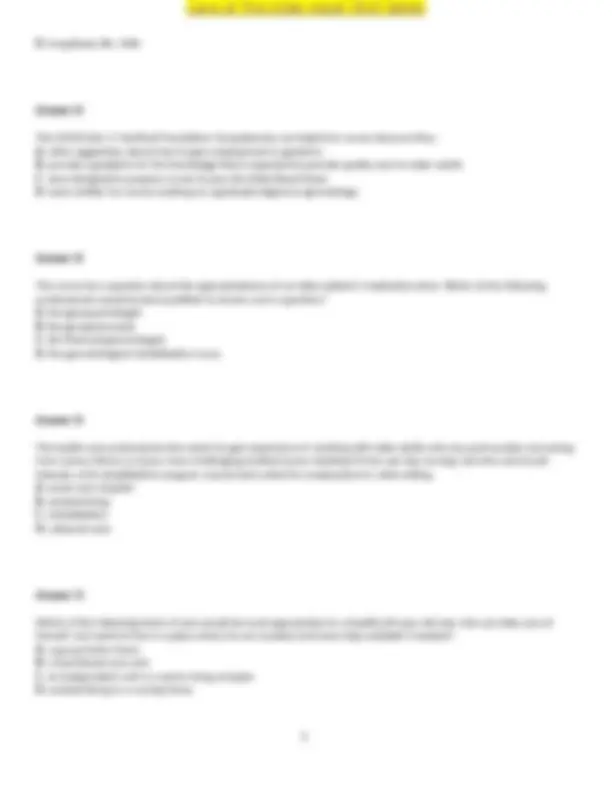
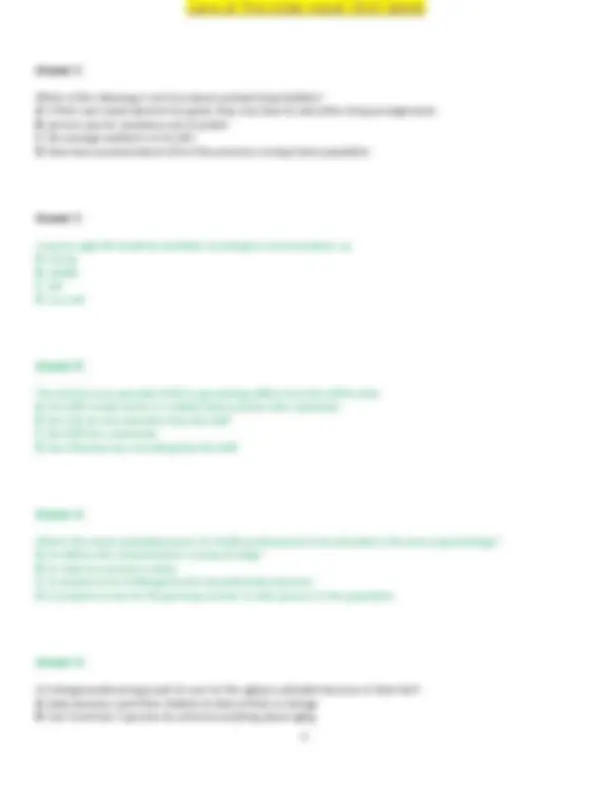
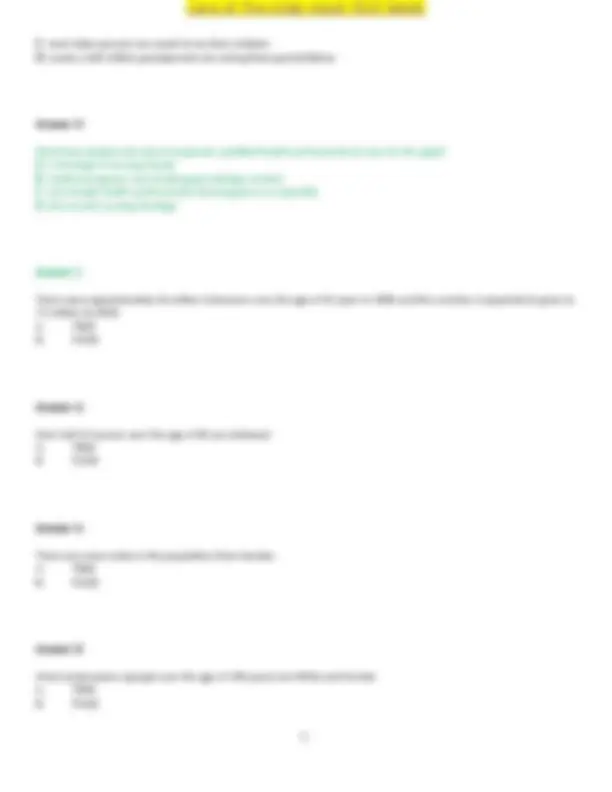
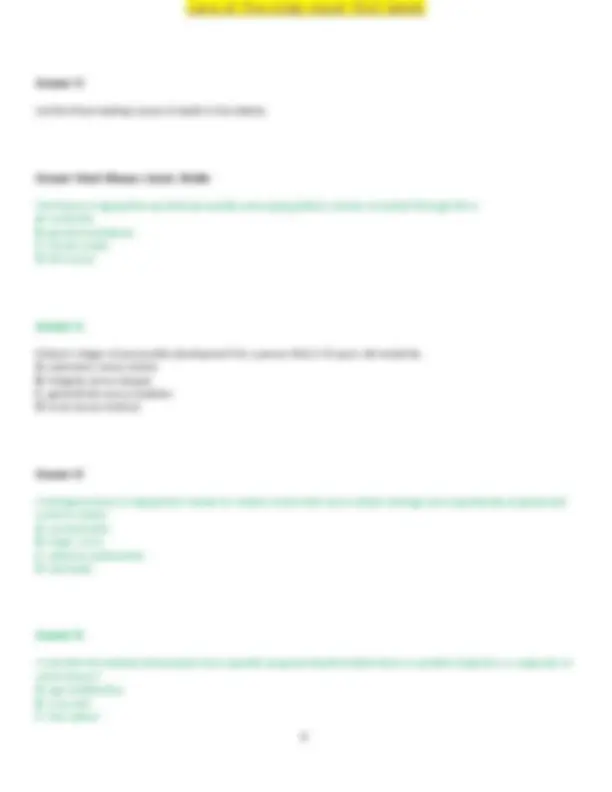
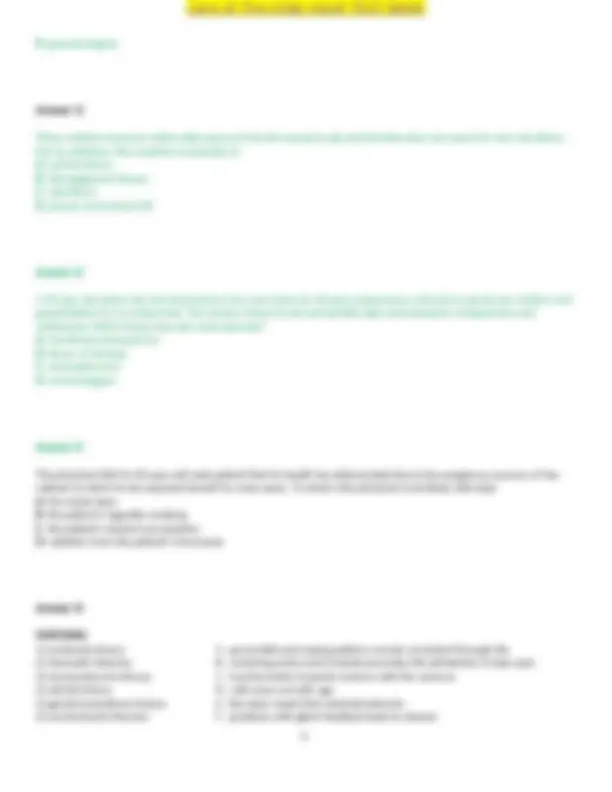
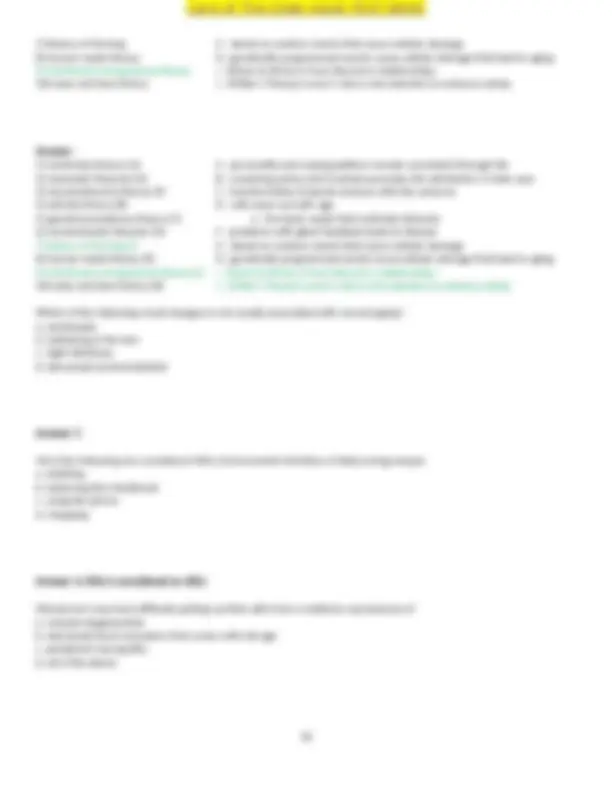
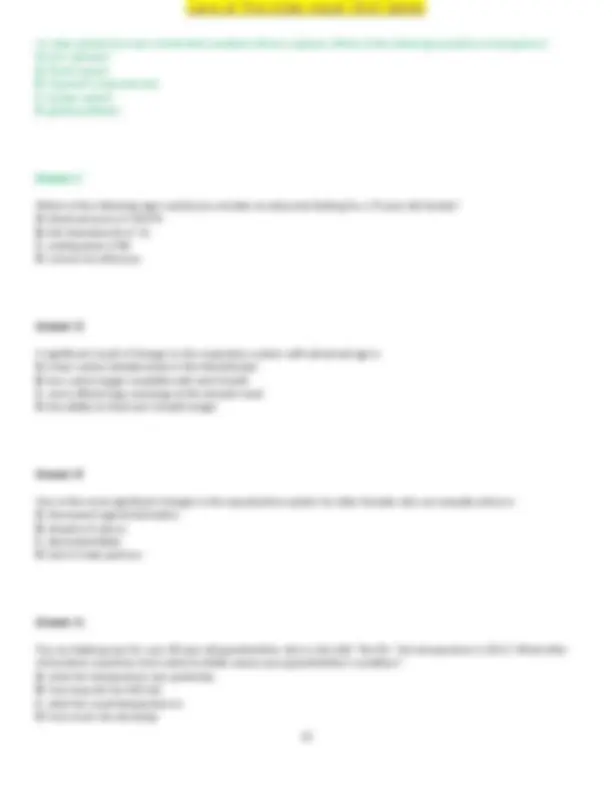
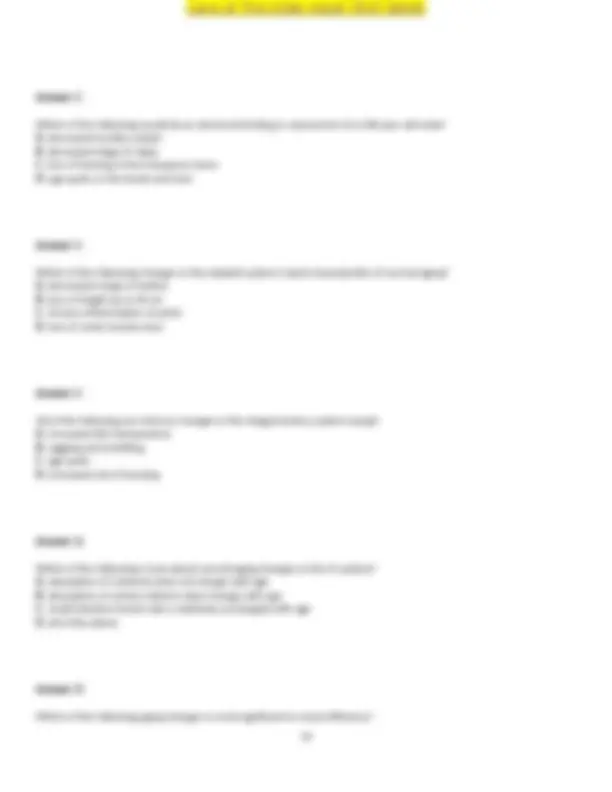
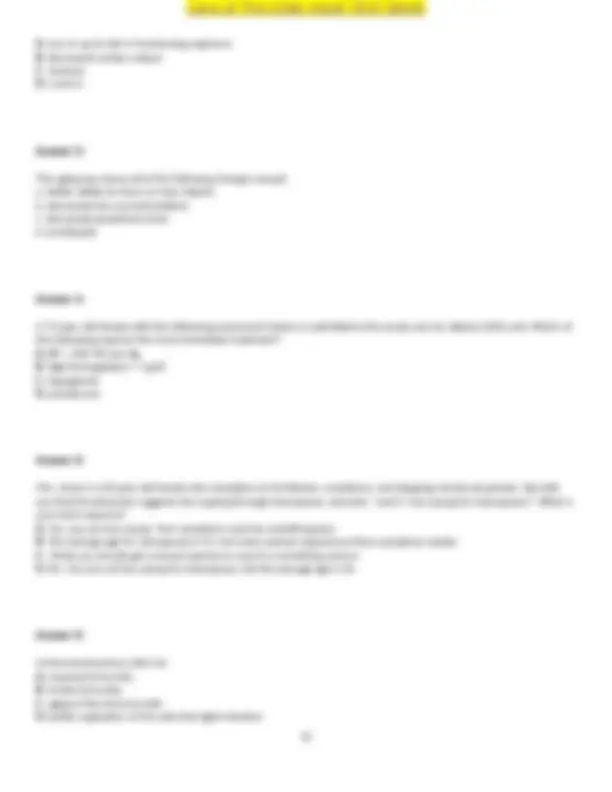
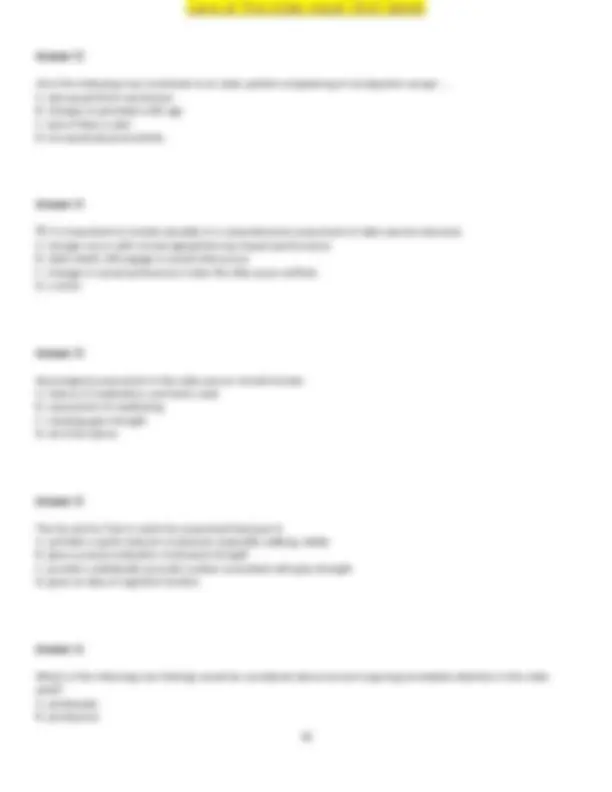
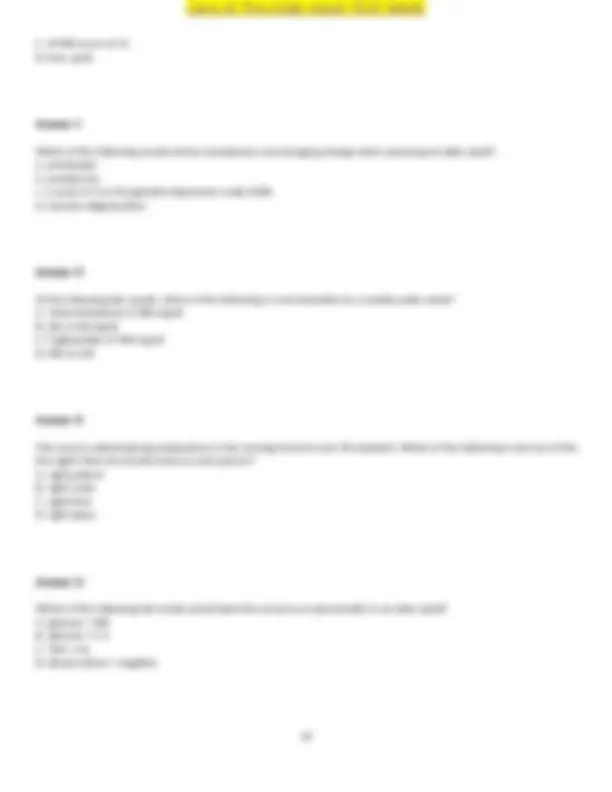
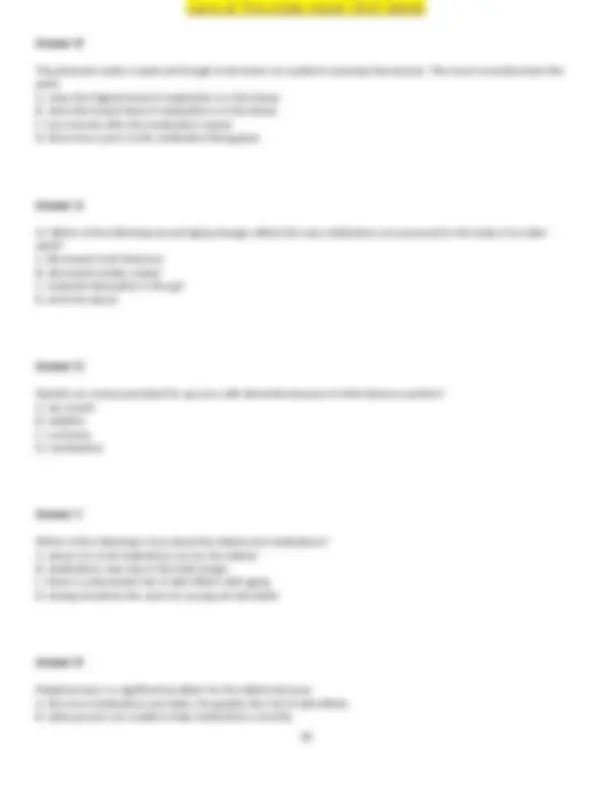
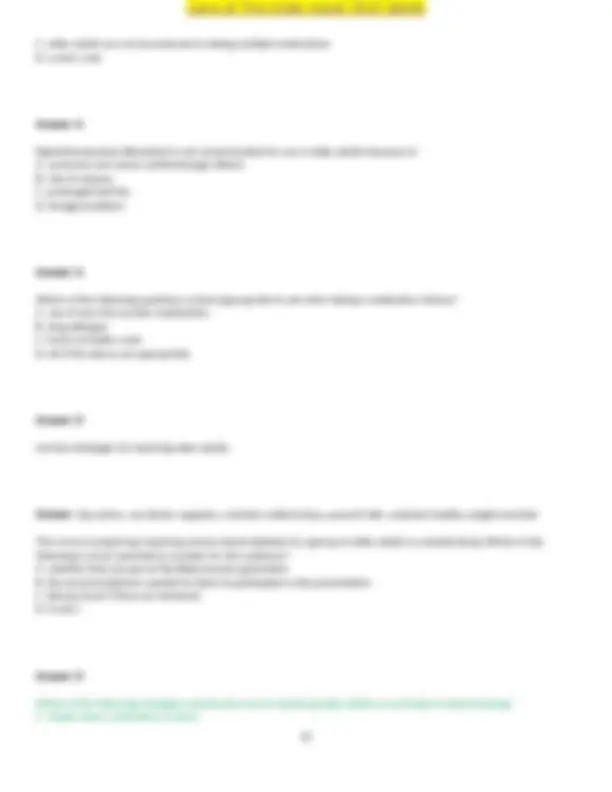
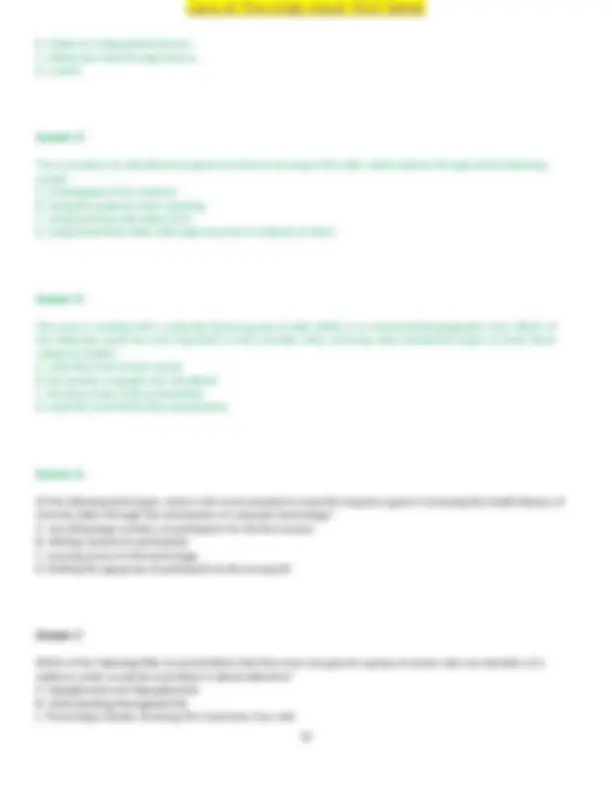
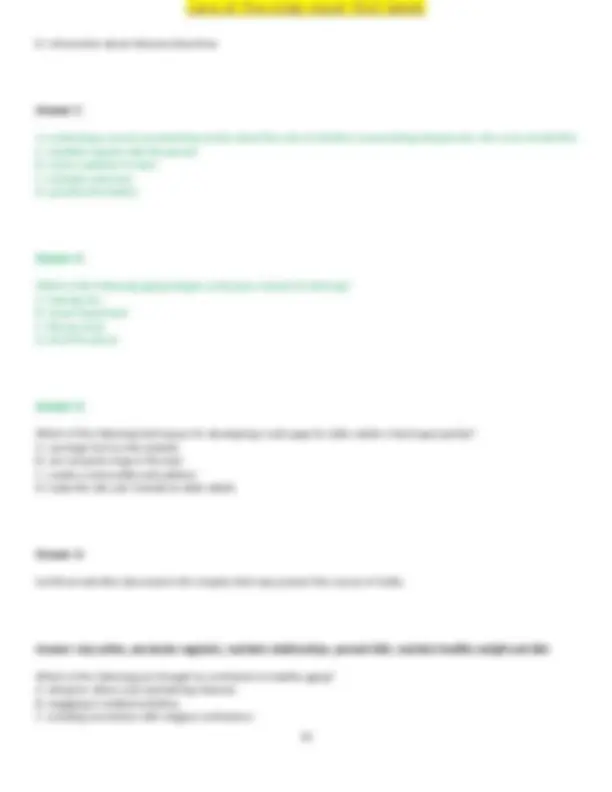
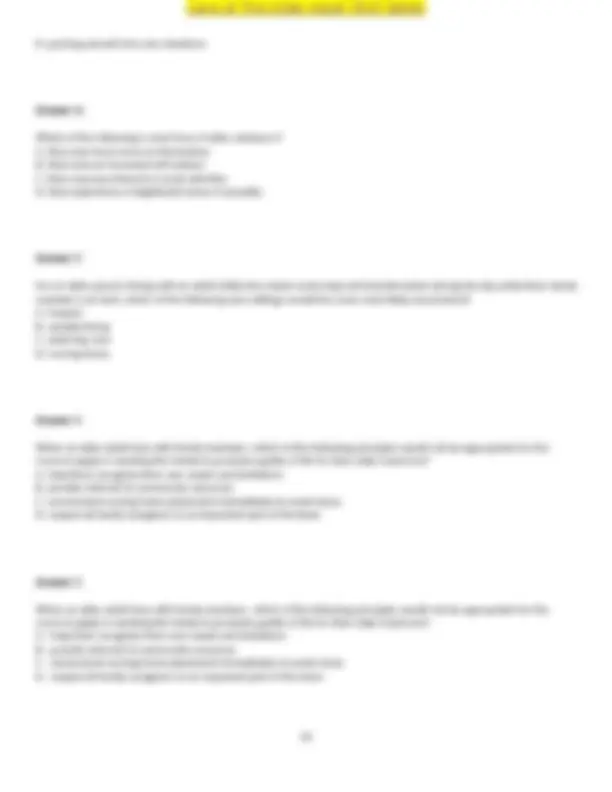
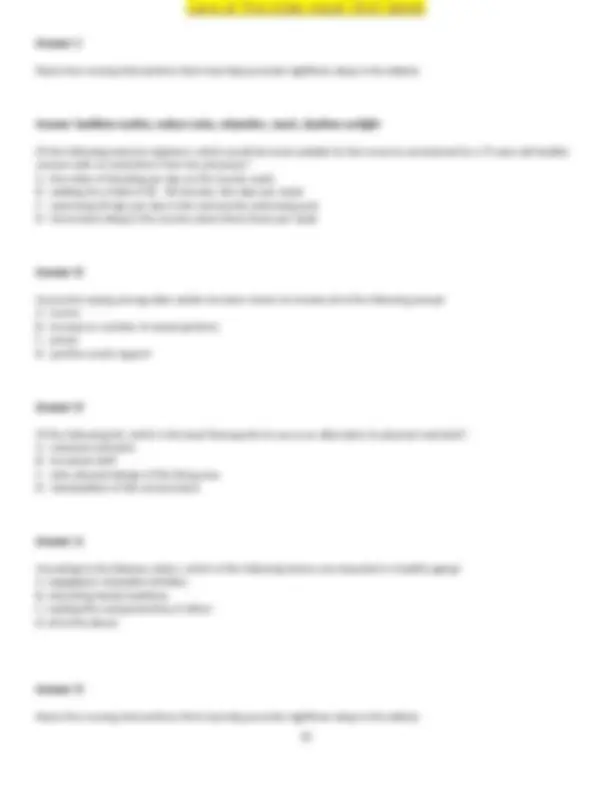
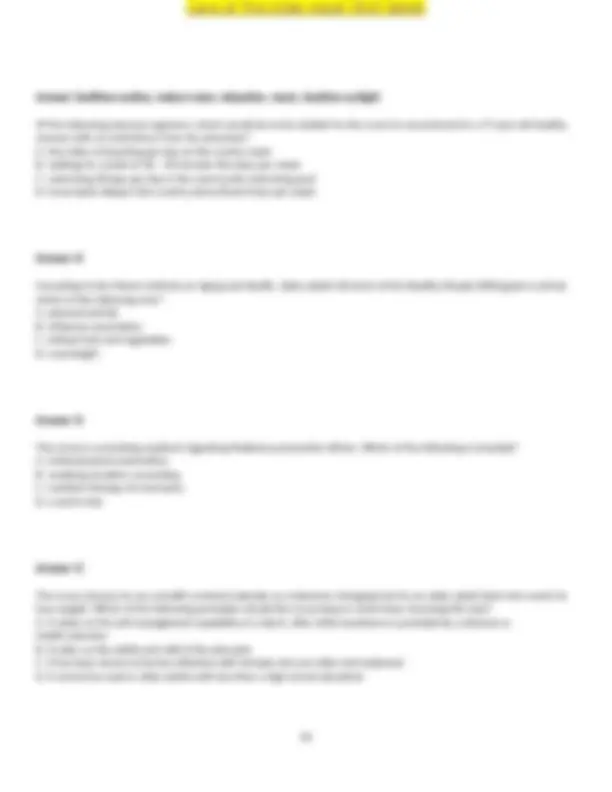
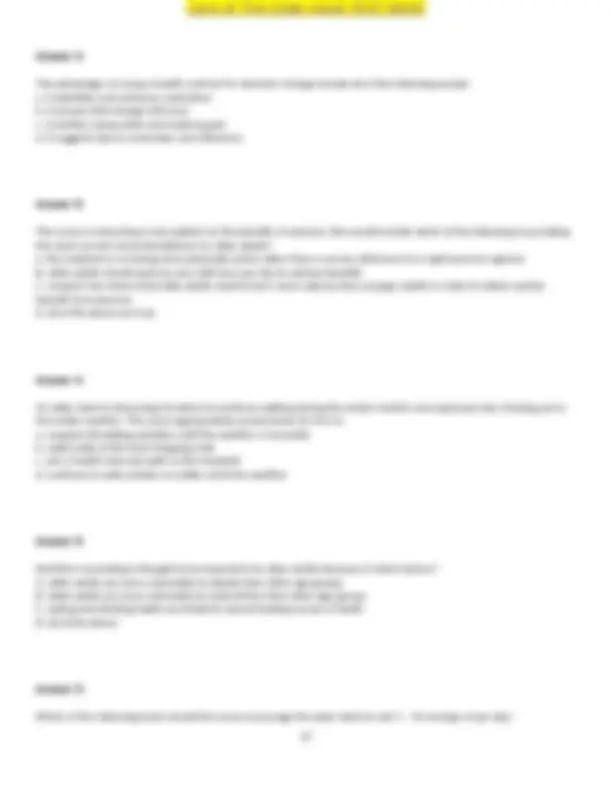
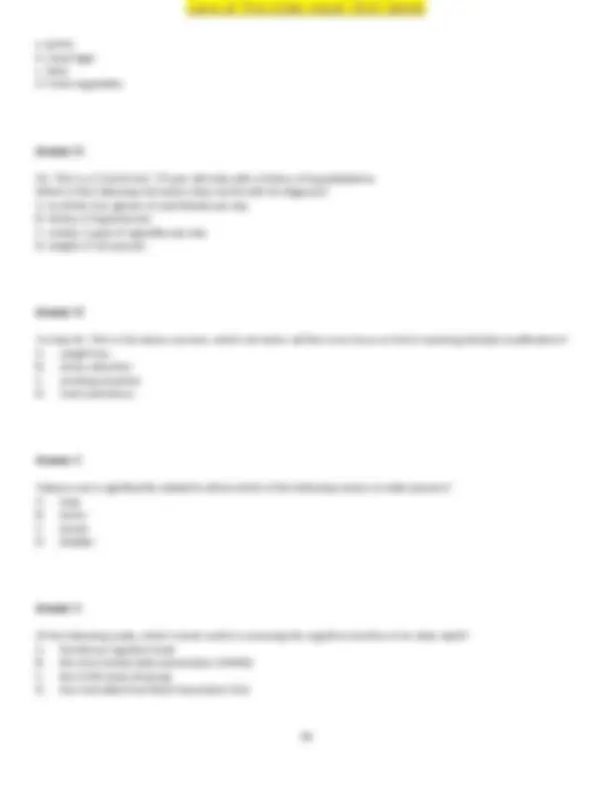
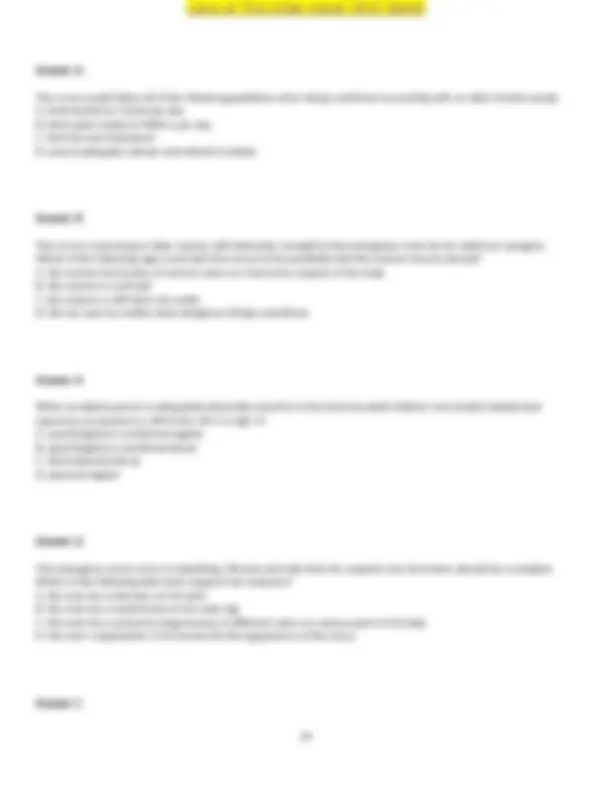
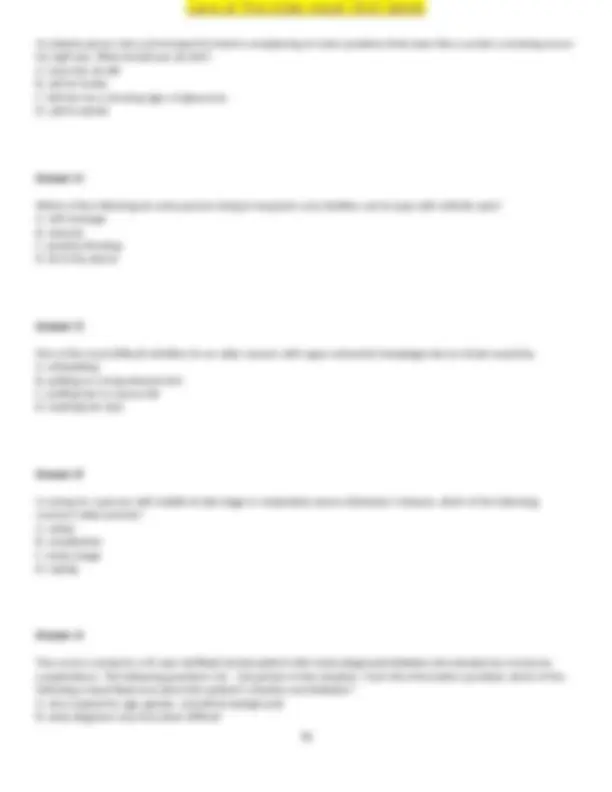
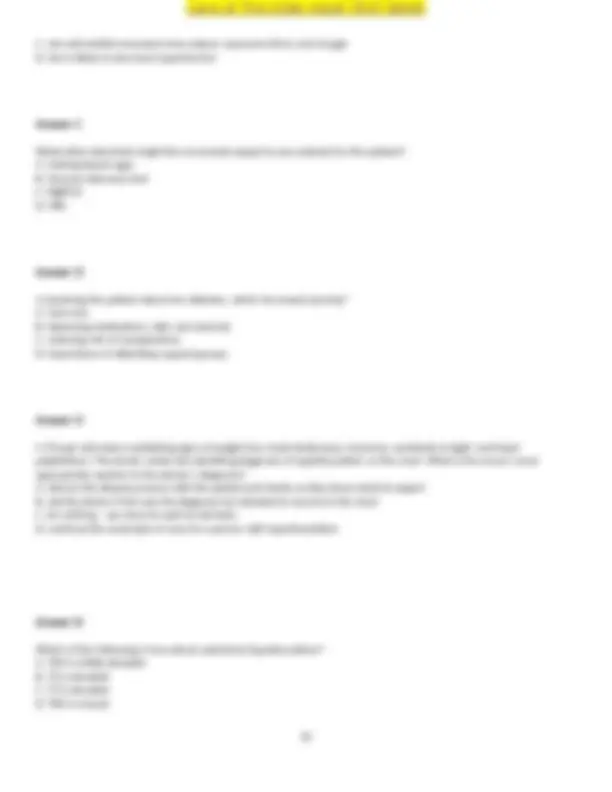
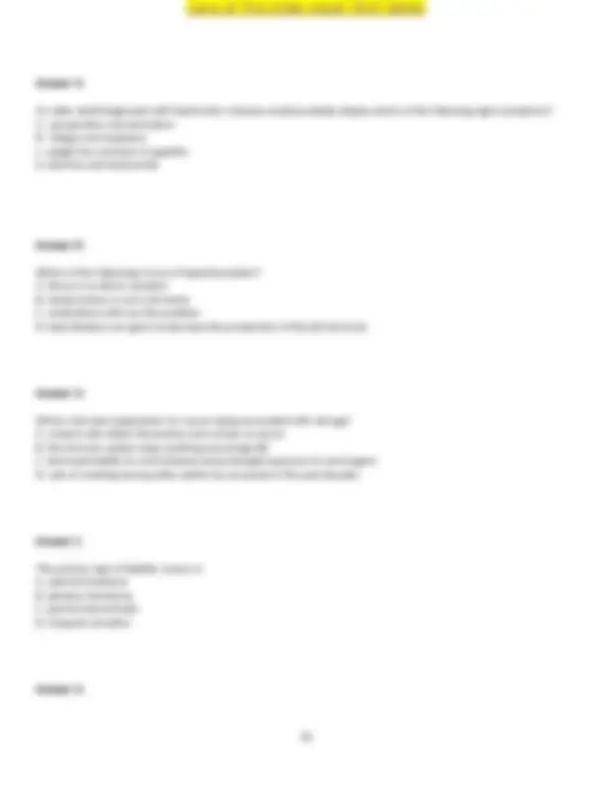
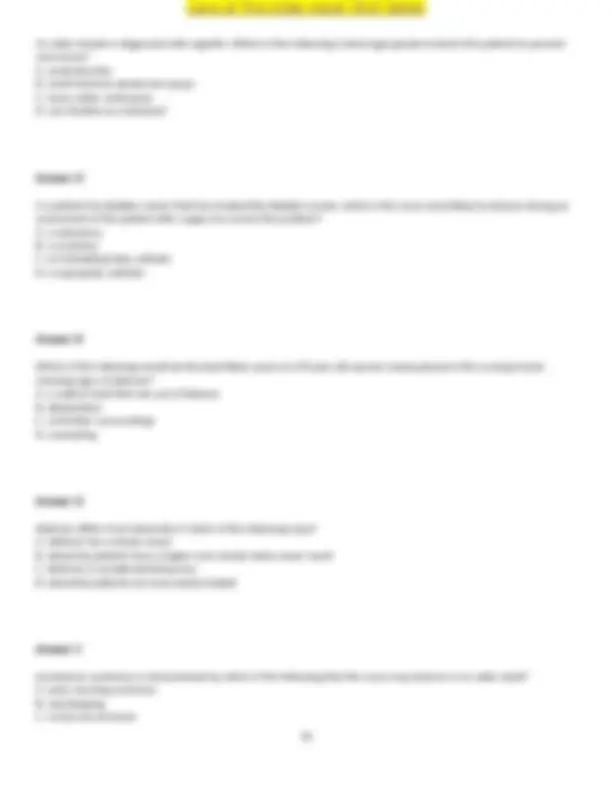
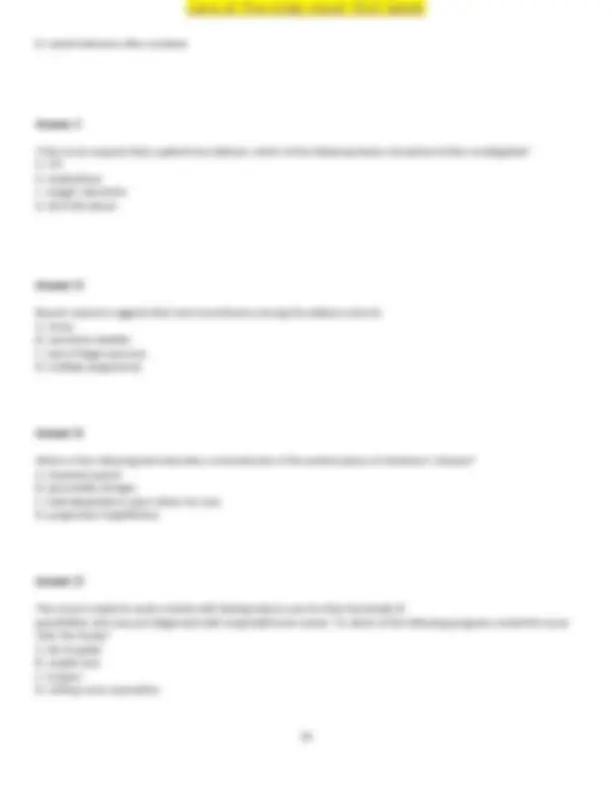
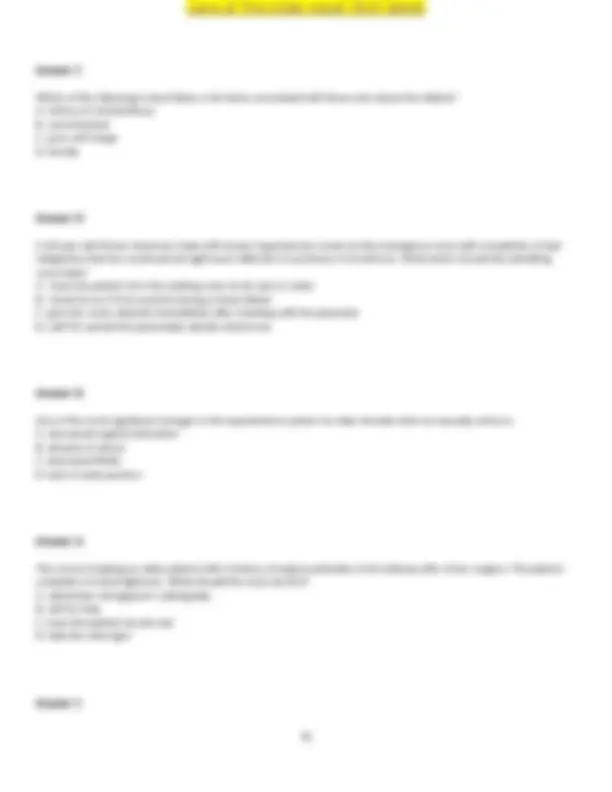
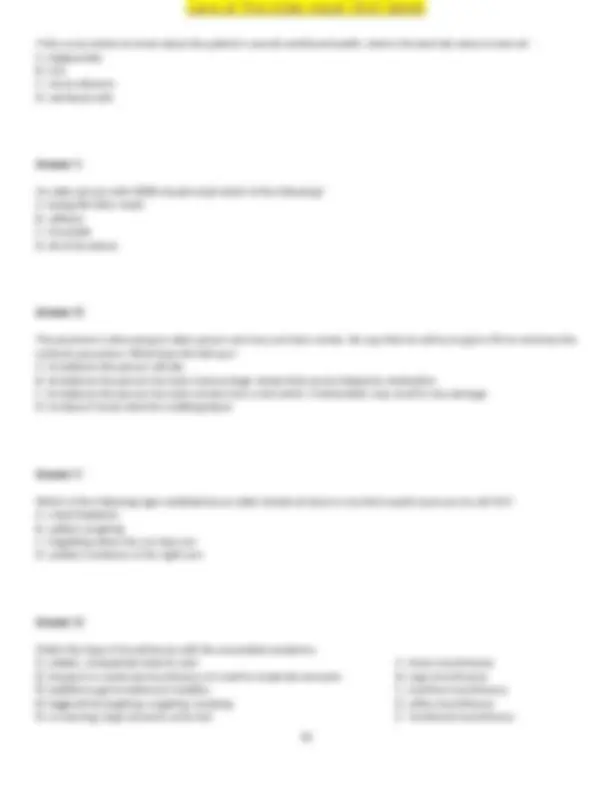
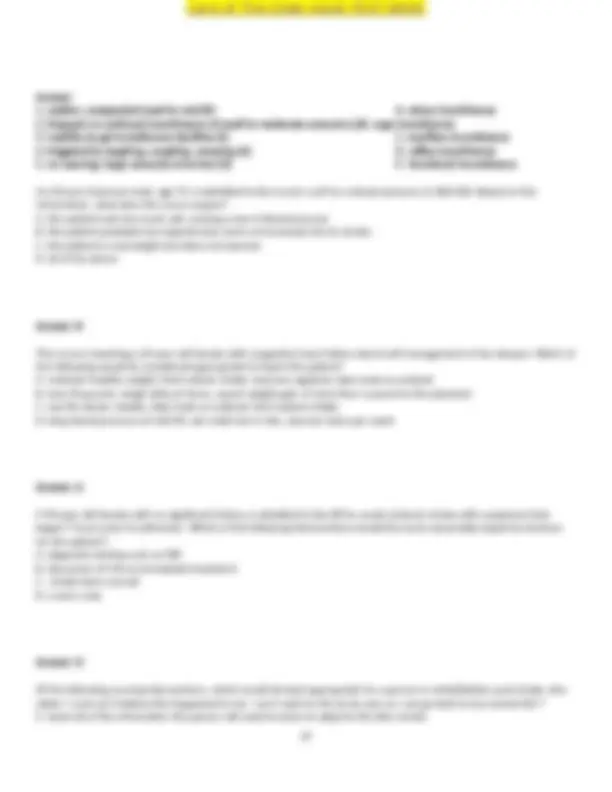
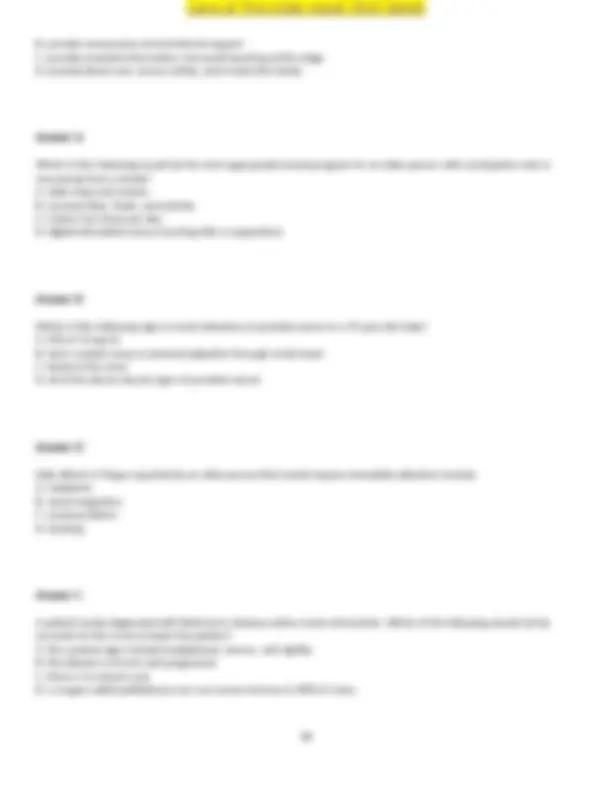
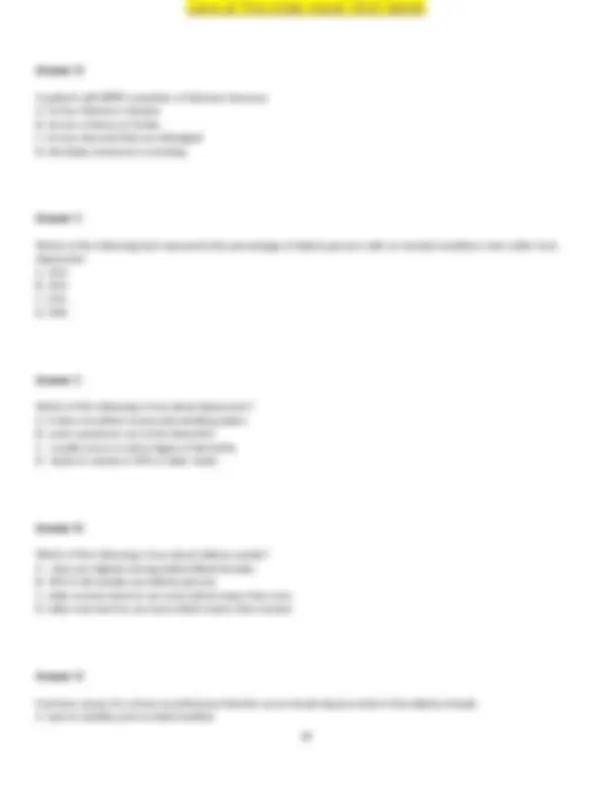
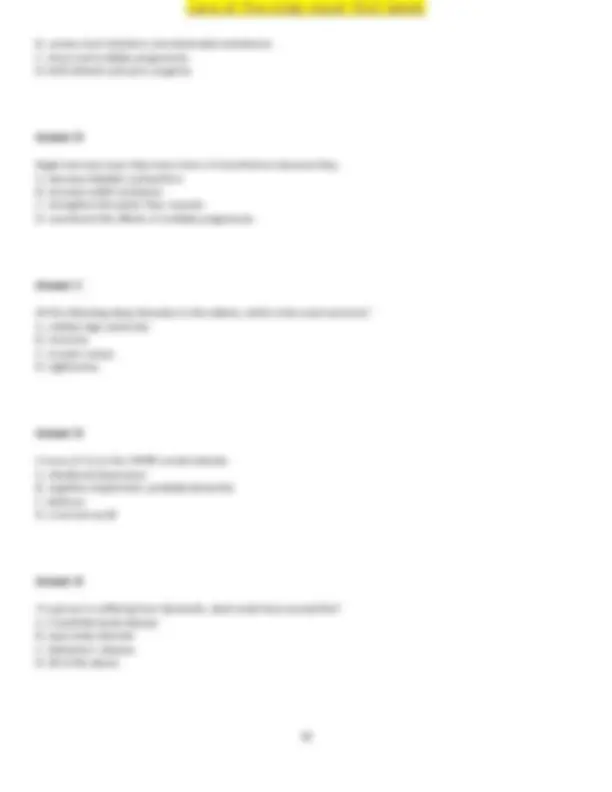
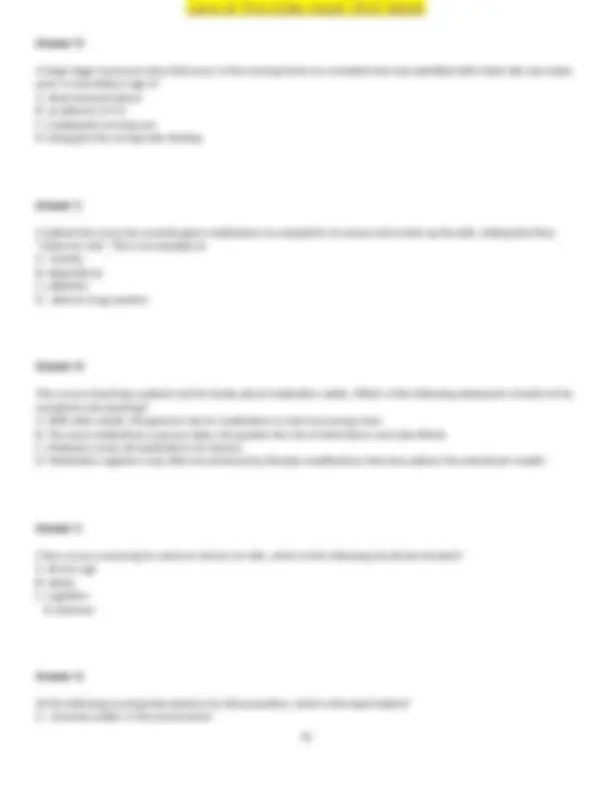
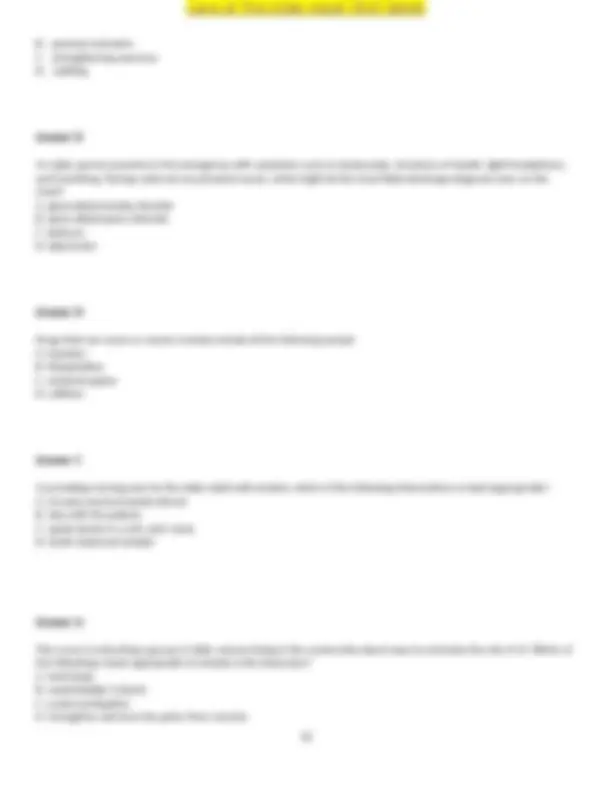
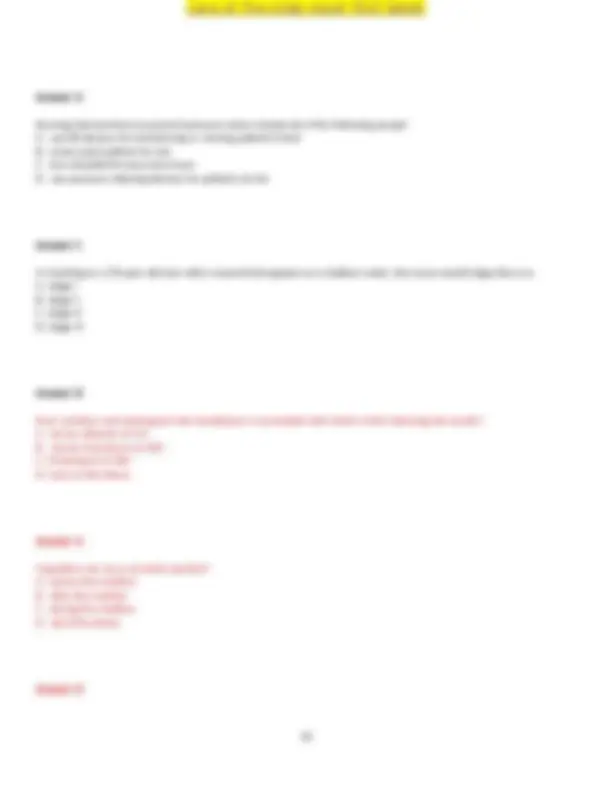

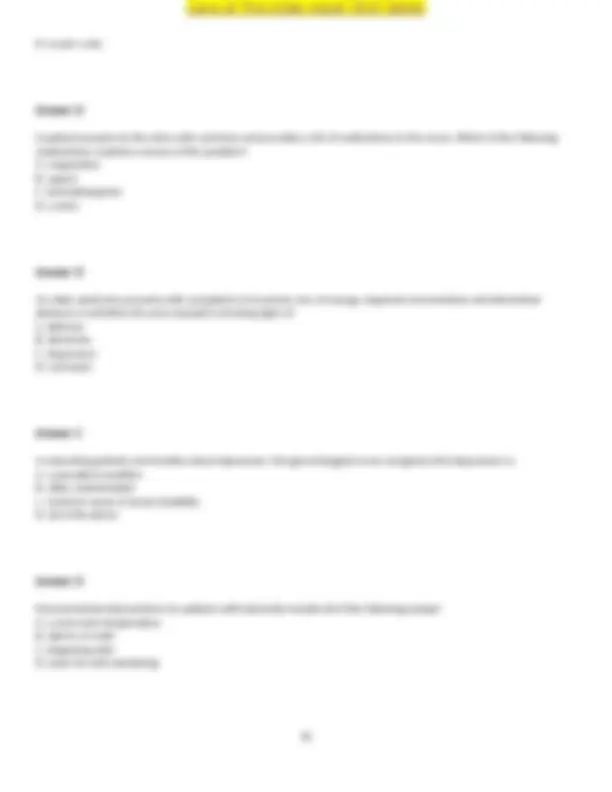
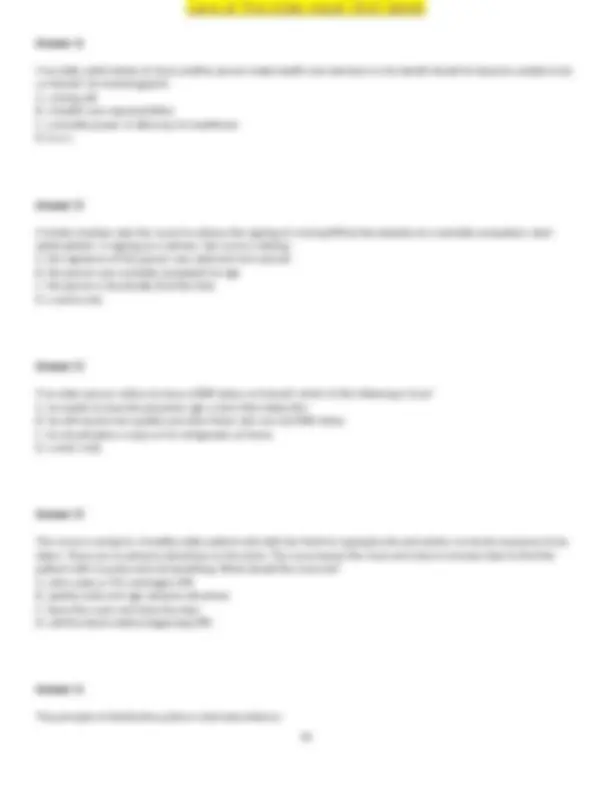
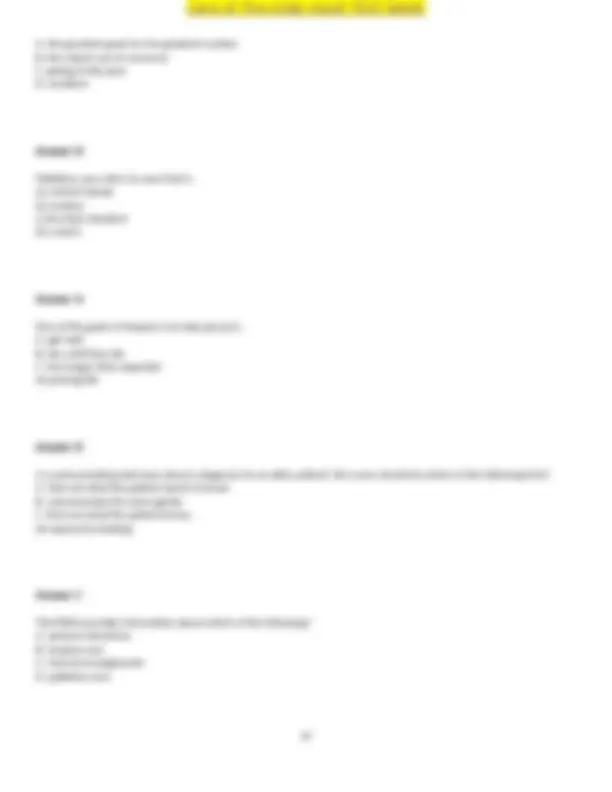
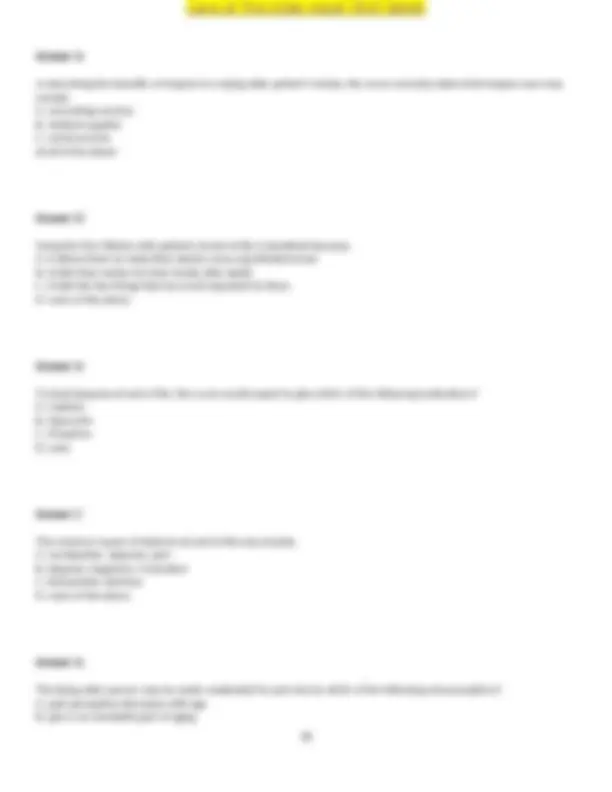
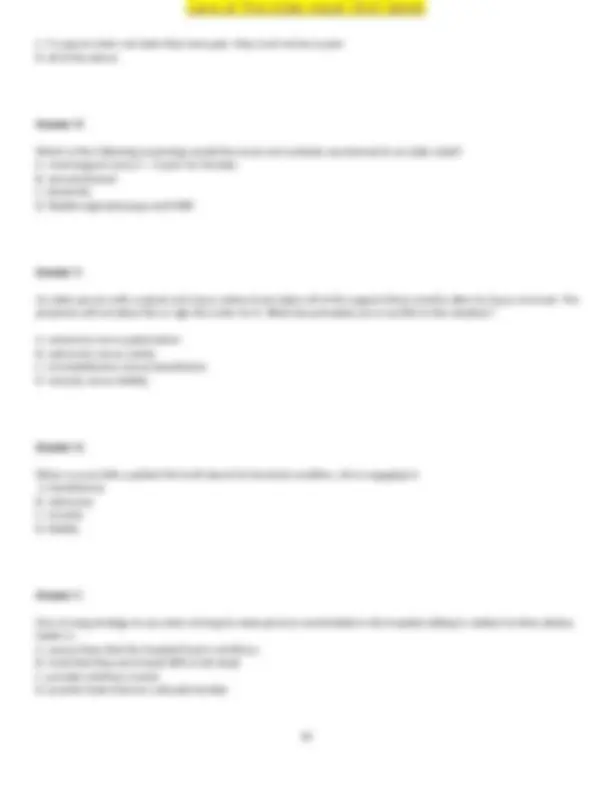
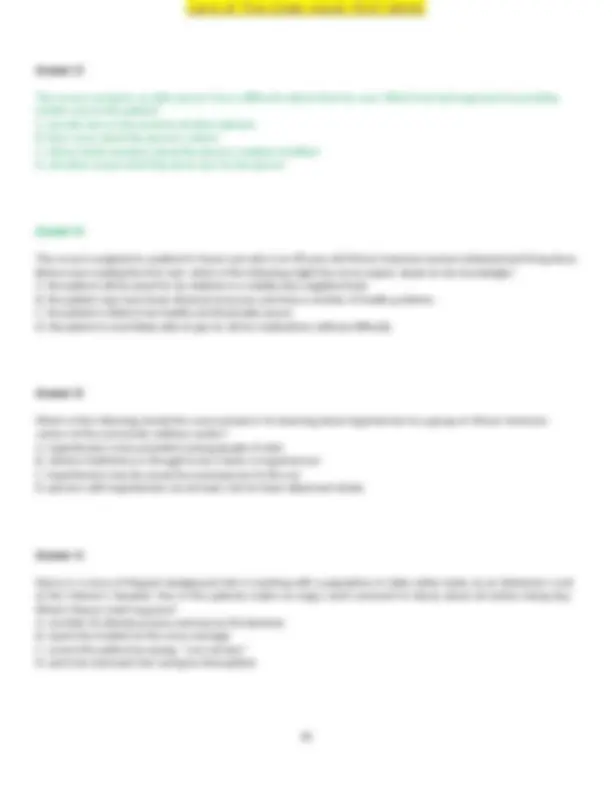
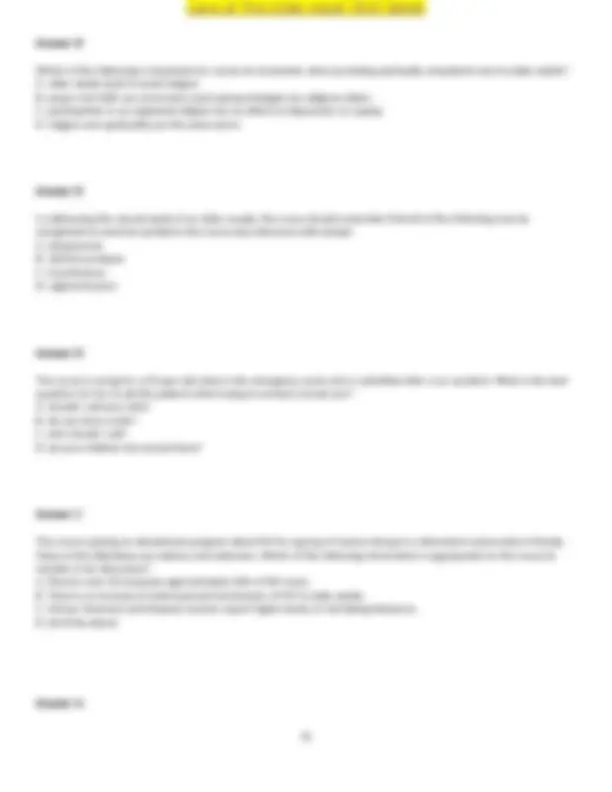
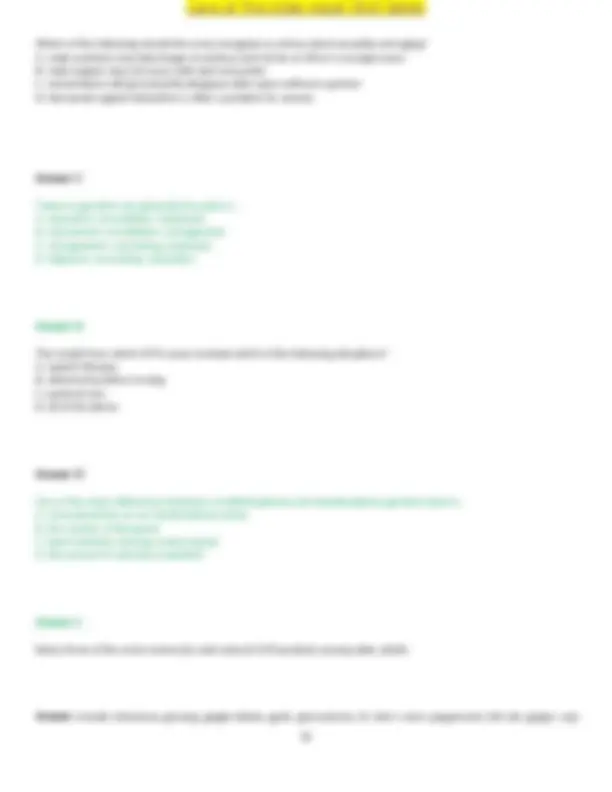
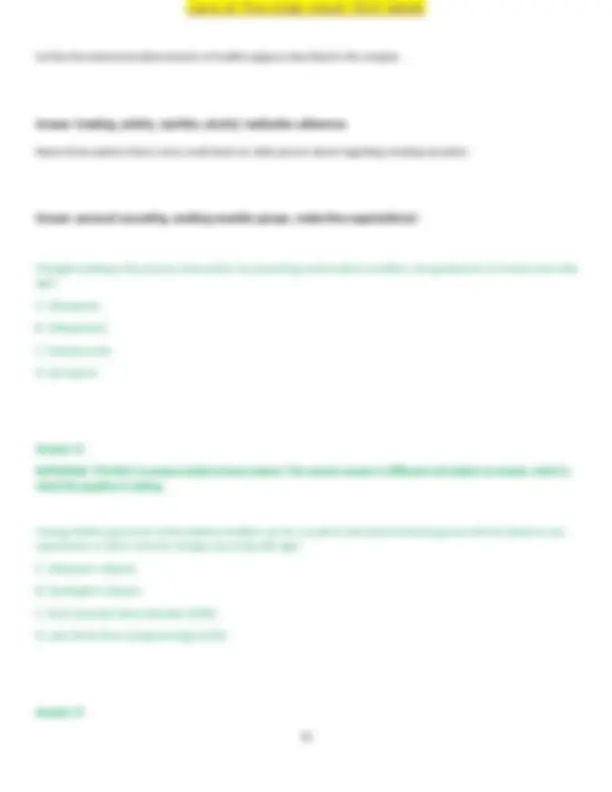
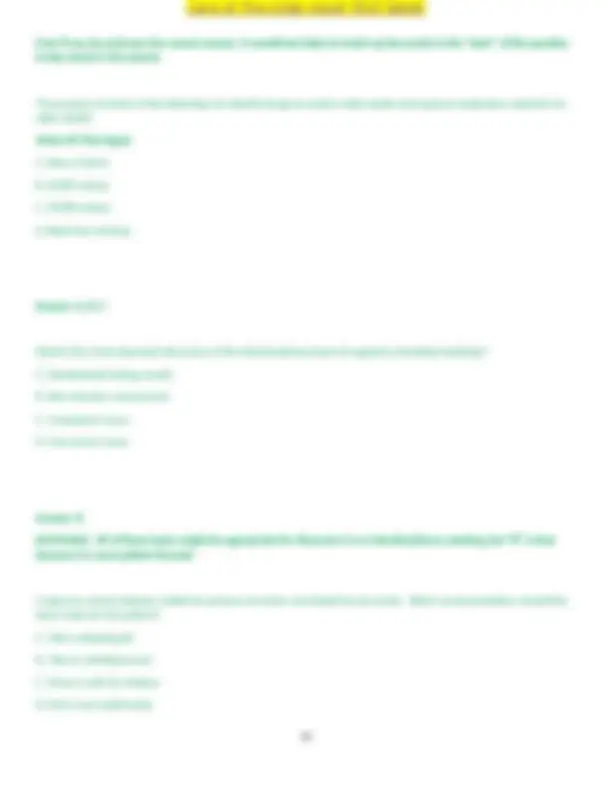
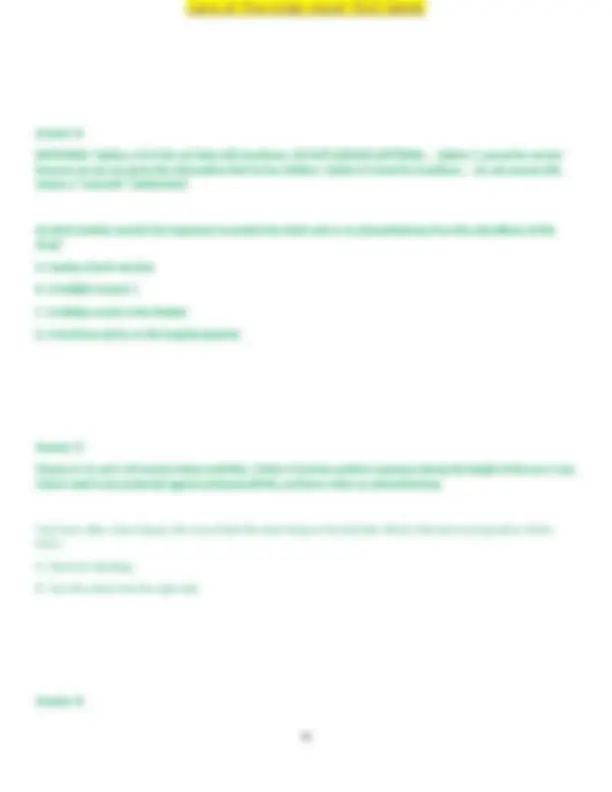
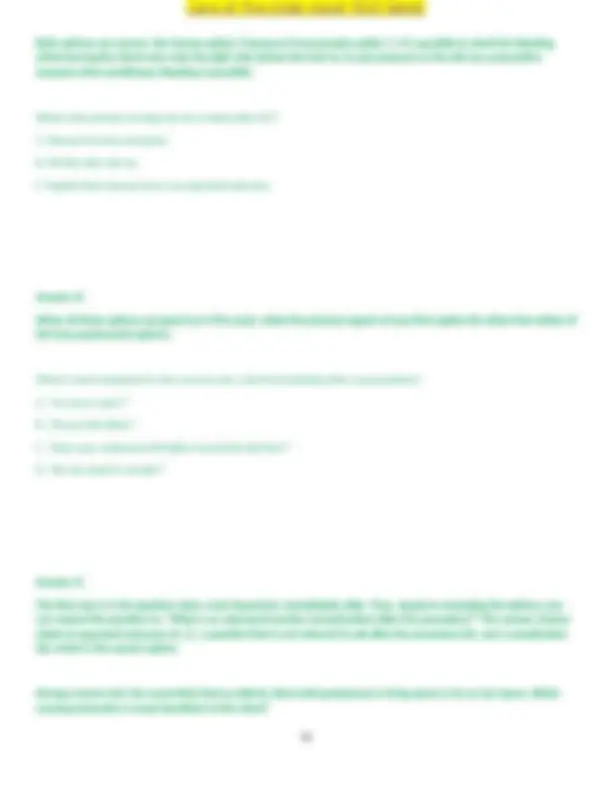
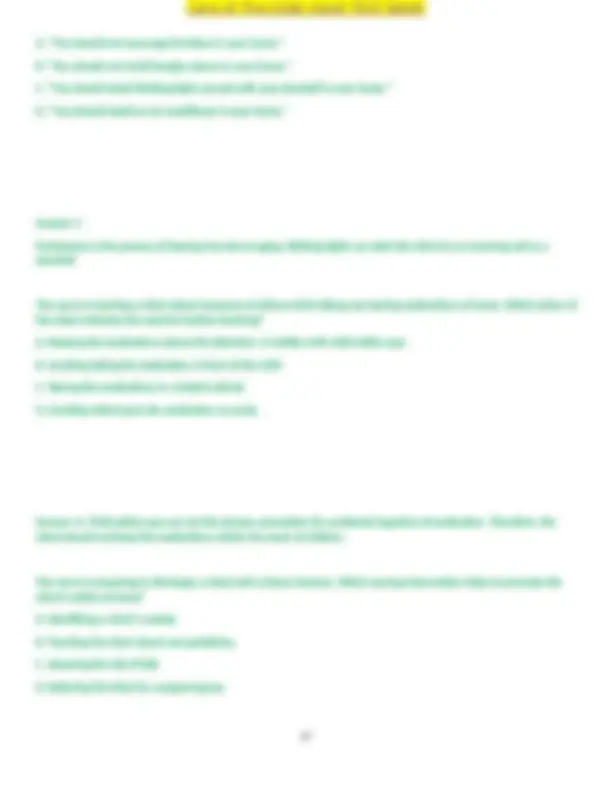
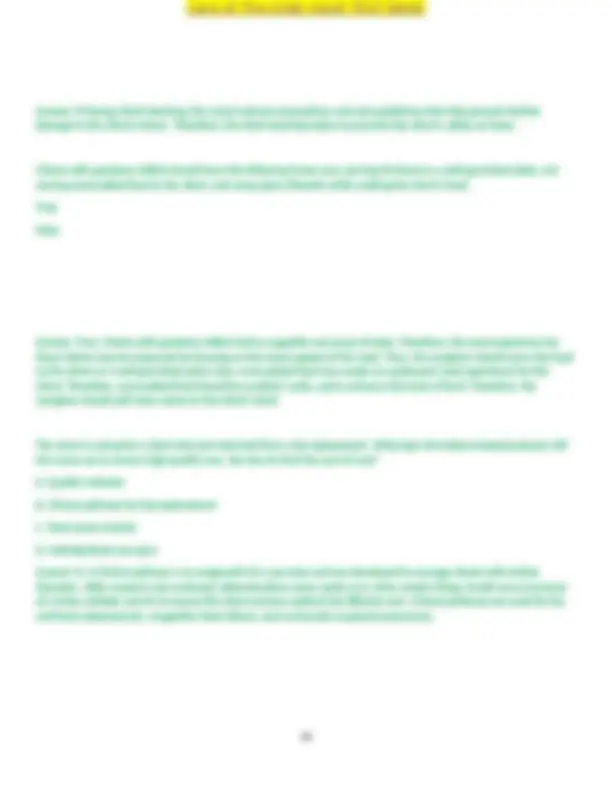


Study with the several resources on Docsity

Earn points by helping other students or get them with a premium plan


Prepare for your exams
Study with the several resources on Docsity

Earn points to download
Earn points by helping other students or get them with a premium plan
Community
Ask the community for help and clear up your study doubts
Discover the best universities in your country according to Docsity users
Free resources
Download our free guides on studying techniques, anxiety management strategies, and thesis advice from Docsity tutors
Care of The Older Adult TEST BANK
Typology: Exams
1 / 58

This page cannot be seen from the preview
Don't miss anything!



















































A negative attitude towards aging and the aged is called: A. geriatrics B. racism C. ageism D. ethnocentrism Answer: C Which of the following is not considered a core competency for nurses caring for older adults? A. Analyze the impact of an aging society on the health care system B. Obtain certification in gerontological nursing C. Prevent or reduce common risk factors that contribute to functional decline D. Recognize one's own attitudes about aging Answer: B The nurse wishes to obtain basic certification in the specialty of gerontological nursing. Which of the following is true about this credential? A. there is an experience requirement B. one must pass an exam C. one must have a BSN D. a and b only Answer: D When the nurse reads an article and uses the findings of a study to improve the quality of the patients for whom she cares, she is implementing the role of: A. teacher B. manager C. research consumer D. advocate Answer: C A lawyer wishes to hire a nurse consultant who has advanced education and certification in gerontology. Based on their listed credentials, which of the following nurses best fits his wishes? A. Sally Smith, RN, BSN, BC
B. Mary Malloy, RN, MS, GNP C. Andy Jones, LPN, CRRC
Answer: C Which of the following is not true about assisted living facilities? A. if their care needs become too great, they may have to seek other living arrangements B. persons pay for assistance out of pocket C. the average resident is in his 60's D. they have assumed about 15% of the previous nursing home population Answer: C A person aged 84 would be classified, according to current systems, as: A. young B. middle C. old D. very old Answer: B The clinical nurse specialist (CNS) in gerontology differs from the GNP in that: A. the GNP usually works in a collaborative practice with a physician B. the CNS has less education than the GNP C. the GNP has a doctorate D. the CNS does less consulting than the GNP Answer: A What is the most compelling reason for health professionals to be educated in the area of gerontology? A. to address the comprehensive nursing shortage B. to make an increase in salary C. to prepare to be challenged by the educated baby boomers D. to prepare to care for the growing number of older persons in the population Answer: D An intergenerational approach to care for the aging is advisable because of what fact? A. baby boomers want their children to take of them in old age B. Gen X and Gen Y persons do not know anything about aging
C. most older persons are cared for by their children D. nearly a half million grandparents are raising their grandchildren Answer: D What best explains the lack of prepared, qualified health professionals to care for the aged? A. a shortage of nursing faculty B. medical programs not including gerontology content C. not enough health professionals choosing gero as a specialty D. the current nursing shortage Answer: C There were approximately 36 million Americans over the age of 65 years in 2000 and this number is expected to grow to 71 million by 2030 A. TRUE B. FALSE Answer: A Over half of women over the age of 85 are widowed A. TRUE B. FALSE Answer: A There are more males in the population than females A. TRUE B. FALSE Answer: B Most centenarians (people over the age of 100 years) are White and female A. TRUE B. FALSE
Answer: B (It's Heart Disease, Cancer and Strokes) Which ethnic/cultural group has a higher rate of diabetes, hypertension, and chronic renal disease than other ethnic groups? A. African Americans B. Hispanics C. Asians and Pacific Islanders D. American Indians and Alaskan natives Answer: A Which ethnic/cultural group is the most rapidly growing ethnic minority, and less likely to obtain preventive services such as flu vaccines and mammograms? A. African Americans B. Hispanics C. Asians and Pacific Islanders D. American Indians and Alaskan natives Answer: B Which ethnic/cultural group is comprised of many subgroups and generally have a longer life expectancy than white Americans? A. African Americans B. Hispanics C. Asians and Pacific Islanders D. American Indians and Alaskan natives Answer: C Which ethnic/cultural group makes up a small percentage of America's elderly population and have increased morbidity and mortality related to diabetes and renal disease? A. African Americans B. Hispanics C. Asians and Pacific Islanders D. American Indians and Alaskan natives
Answer: D List the three leading causes of death in the elderly: Answer: Heart disease, Cancer, Stroke The theory of aging that says that personality and coping patterns remain consistent through life is: A. continuity B. gerotranscendence C. human needs D. life course Answer: A Erikson's stages of personality development for a person that is 76 years old would be: A. autonomy versus shame B. integrity versus despair C. generativity versus isolation D. trust versus mistrust Answer: B A biological theory of aging that is based on random events that cause cellular damage versus genetically programmed events is called: A. nonstochastic B. Orgel / error C. selective optimization D. stochastic Answer: B A scientist who believes that people have a genetic programming that determines or predicts longevity is a supporter of which theory? A. age stratification B. cross-link C. free radical
Answer: D An older adult who complains of a dark spot in the center of the visual field is showing signs of: A. cataracts B. macular degeneration C. acute glaucoma D. diabetic retinopathy Answer: B An older adult who complains of seeing dark shadows around the center of the visual field is showing signs of: A. cataracts B. macular degeneration C. glaucoma D. diabetic retinopathy Answer: C An older adult who complains of blurry vision and has a bluish-white coating that can be seen on the lens is showing signs of: A. cataracts B. macular degeneration C. acute glaucoma D. diabetic retinopathy Answer: A Which of the following factors could contribute to an older person's inability to hear instructions given by the nurse? A. cerumen impaction B. nurse not facing the person when giving directions C. loss of high frequency pitches D. all of the above Answer: D The nurse is trying to take a history from a cooperative but fearful older person with mild dementia. Which of the following would be the most therapeutic strategy to use for this interaction? A. sit calmly in a chair next to the person and ask questions in a non-threatening manner
An older patient has had a stroke that resulted in Broca's aphasia. Which of the following would be most typical of Broca's aphasia? A. fluent speech B. impaired comprehension C. broken speech D. global problems Answer: C Which of the following signs would you consider an abnormal finding for a 75 year old female? A. blood pressure of 110/ B. Hct (hematocrit) of. C. resting pulse of 80 D. urinary incontinence Answer: D A significant result of changes in the respiratory system with advanced age is: A. lower carbon dioxide levels in the bloodstream B. less useful oxygen available with each breath C. more efficient gas exchange at the alveolar level D. the ability to hold one's breath longer Answer: B One of the most significant changes in the reproductive system for older females who are sexually active is: A. decreased vaginal lubrication B. atrophy of uterus C. decreased libido D. lack of male partners Answer: A You are helping care for your 89 year old grandmother who is sick with "the flu". Her temperature is 101.2. What other information would be most useful to better assess your grandmother's condition? A. what her temperature was yesterday B. how long she has felt sick C. what her usual temperature is D. how much she ate today
Answer: C Which of the following would be an abnormal finding in assessment of an 80 year old male? A. decreased cardiac output B. decreased stage IV sleep C. loss of hearing of low frequency tones D. age spots on the hands and face Answer: C Which of the following changes in the skeletal system is least characteristic of normal aging? A. decreased range of motion B. loss of height up to 10 cm C. chronic inflammation of joints D. loss of some muscle mass Answer: C All of the following are intrinsic changes in the integumentary system except: A. increased skin temperature B. sagging and wrinkling C. age spots D. increased risk of bruising Answer: A Which of the following is true about normal aging changes in the GI system? A. absorption of nutrients does not change with age B. absorption of certain vitamins does change with age C. small intestine transit rate is relatively unchanged with age D. all of the above Answer: D Which of the following aging changes is most significant to renal efficiency?
Answer: C Which of the following is a reason why older females may develop vaginitis? A. lower estrogen levels B. atrophy of the vaginal canal C. decreased lubrication of the vagina D. all of the above Answer: D The nurse wishes to use a tool to help assess the functional status of the older residents in the nursing home where she works. Which of the following would be least appropriate for this purpose? a. Katz index b. MDS c. Barthel Index d. Gibson self-care scale Answer: D Which of the following is the best example of an open-ended question/statement that would promote verbalization from an older person? A. tell me about your major problem today B. do you have any complaints today? C. are you having any major problems? D. do you want to talk about your major complaint? Answer: Name four essential areas to address to promote communication as discussed in this chapter. Answer: Invite-respect, Environment, Understanding, Communication Changes in which of the following body systems are generally most noticeable to the naked eye? A. respiratory B. integumentary
C. gastrointestional D. neurological Answer: The nurse working in rehabilitation would most likely see what measure used to evaluate progress of patients in rehabilitation? A. Katz index B. MDS C. FIM D. OASIS Answer: C In assessing IADLs, the nurse will ask questions about all but which of the following patient activities? a. cooking b. shopping C. using the phone D. bathing Answer: D In assessing the circulatory system of an older adult, the nurse would recognize which of the following as abnormal? A. resting pulse rate of 120 B. blood pressure of 118/ C. respirations of 26 D. a and c Answer: D When assessing the respiratory system of an older person, which of the following is the least essential to ask during history taking? A. use of tobacco products B. feelings of shortness of breath C. exposure to environmental toxins D. all are important to ask about
C. MMSE score of 12 D. liver spots Answer: C Which of the following would not be considered a normal aging change when assessing an older adult? a. presbyopia b. presbycusis c. a score of 3 on the geriatric depression scale (GDS) d. macular degeneration Answer: D Of the following lab results, which of the following is most desirable for a healthy older adult? A. Total cholesterol of 300 mg/dl B. LDL of 60 mg/dl C. Triglycerides of 400 mg/dl D. FBS of 235 Answer: B The nurse is administering medications in the nursing home to over 40 residents. Which of the following is not one of the five rights that she should check on each person? A. right patient B. right route C. right time D. right place Answer: D Which of the following lab results would alert the nurse to an abnormality in an older adult? A. glucose = 100 B. albumin = 2. C. TSH = 4. D. blood culture = negative
Answer: B The physician orders a peak and trough to be drawn on a patient receiving Vancomycin. The nurse correctly draws the peak: A. when the highest level of medication is in the blood B. when the lowest level of medication is in the blood C. two minutes after the medication is given D. three hours prior to the medication being given Answer: A